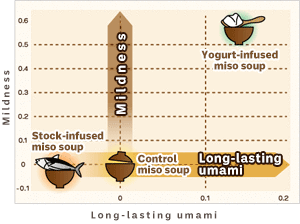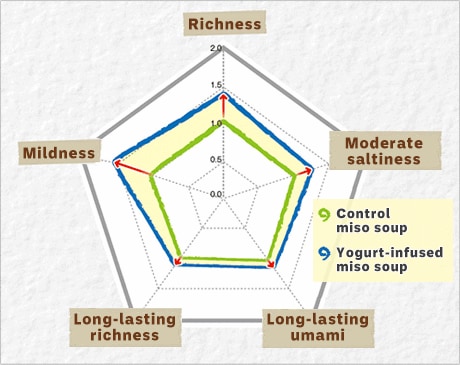|

Yogurt×miso soup
We conducted an experiment using a taste sensor to measure the richness and tastiness of yogurt miso soup.
|
Yogurt goes perfectly with salted rice malt and other fermented foods, and so it’s highly compatible with miso, which is one of the best-known fermented foods unique to Japan. How come they are so tasty together?
|
 |
 |
Hypothesis: Does adding yogurt increase umami (savoriness)?
As miso and yogurt are both fermented foods and compatible for use in cooking, they are considered one of the best combinations to boost umami (savoriness) and nutrition. But does adding yogurt to miso soup actually increase its umami?
To test this theory, we took some measurements using a taste sensor that can quantify the taste of food.
We prepared the following three types of miso soup for comparison.
- ・Basic miso soup as control (water + miso)
- ・Miso soup with stock (water + miso + stock)
- ・Yogurt-infused miso soup (water + miso + yogurt)
Measurement started: Six different tastes were measured with the taste sensor and for conversion into numerical data.
While taste may be perceived differently by each person, the taste sensor used in this experiment is able to quantify the levels of the key components of deliciousness in food -- umami, bitterness, saltiness, sourness, sweetness, and astringency -- and express them in the form of objective data. The device can measure what cannot be detected by component analysis, and can also acquire the taste data in a manner similar to the human tongue, including food’s initial taste and aftertaste. By using the device, it’s possible to measure complex tastes such as odd flavors and the bitter aftertaste typical of herbs used in traditional Chinese medicine, etc.
Comparison: Better-tasting than the stock-infused miso soup
|
One of the surprising outcomes from the measurement was the difference between the yogurt-infused miso soup and the stock-infused one. After defining the value of the control miso soup as zero, the difference between the two experimental miso soups became clear. When the two were compared, the yogurt-infused one had milder saltiness and long-lasting umami. Its taste was also sharper than the stock-infused one. Thus, the yogurt-infused miso soup was actually better tasting than the conventional type of miso soup. In other words, yogurt not only works as a substitute for stock but also improves the taste of miso soup.
|
 |
 *Data obtained by Meiji Co., Ltd.
Compared to the stock-infused one,
*Data obtained by Meiji Co., Ltd.
Compared to the stock-infused one,
the yogurt-infused miso soup is superior in terms of mildness and long-lasting umami.
|
Conclusion: Using yogurt to make miso soup improves its richness, and creates a long-lasting and mild tastiness.
|
Even when compared with the control miso soup, the yogurt-infused miso soup was superior in terms of mildness and richness in taste, and more moderate saltiness. To recap, the results of the experiment proved the following:
- (1)Yogurt added to miso soup created the long-lasting richness and good aftertaste.
- (2)It took the edge off the saltiness typical of standard miso soup.
- (3)Yogurt improved the depth of taste and created a milder experience overall.
As we now know that using yogurt in making miso soup enhances its mildness and umami, all family members might enjoy it. If you want to try this idea, just add one tablespoon of yogurt per person to the pot when it’s time to mix in the miso paste. It will improve the richness of the taste, and you’ll feel more satiated when the meal is over.
|
 |
 *Data obtained by Meiji Co., Ltd.
Even in comparison with the control miso soup, the yogurt-infused miso soup was distinctively milder and richer in taste.
*Data obtained by Meiji Co., Ltd.
Even in comparison with the control miso soup, the yogurt-infused miso soup was distinctively milder and richer in taste.
|

|
 |
This is the world’s first-ever sensor capable of measuring tastes.
The device was jointly developed by Kyushu University and Intelligent Sensor Technology, Inc. It measures tastes by using an artificial lipid membrane that simulates the human tongue, and converts the acquired basic gustatory data into numerical values.
For this experiment, we also received the support of Taste & Aroma Strategic Research Institute Co., Ltd. in performing analyses using the taste sensor.

|
|





